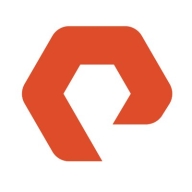


Find out what your peers are saying about Dell Technologies, NetApp, Hewlett Packard Enterprise and others in All-Flash Storage.
| Product | Market Share (%) |
|---|---|
| Dell Unity XT | 6.3% |
| Pure FlashArray X NVMe | 1.0% |
| Oracle FS1 Flash Storage System | 0.2% |
| Other | 92.5% |


| Company Size | Count |
|---|---|
| Small Business | 15 |
| Midsize Enterprise | 11 |
| Large Enterprise | 12 |
| Company Size | Count |
|---|---|
| Small Business | 61 |
| Midsize Enterprise | 49 |
| Large Enterprise | 94 |
Pure Storage FlashArray//X is the world’s first enterprise-class, all-NVMe flash storage array. It represents a new class of storage – shared accelerated storage, which is a term coined by Gartner – that delivers major breakthroughs in performance, simplicity, and consolidation.
Dell EMC Unity XT is one of the best all-flash storage arrays on the market today. Dell EMC Unity XT arrays are designed for performance, optimized for efficiency, and built for a multi-cloud world. In addition, they support digital transformation, enabling businesses to reach the full potential of their data capital quickly and easily. Dell EMC Unity’s All-Flash and Hybrid Flash storage platforms provide the performance, efficiency, enterprise-class software, and virtualization integrations required for running a wide range of virtualized applications.
Dell EMC Unity XT Features
Dell EMC Unity XT has many valuable key features, including:
Dell EMC Unity XT Benefits
Some of the benefits of using Dell EMC Unity XT include:
Reviews from Real Users
Below are some reviews and helpful feedback written by Dell EMC Unity XT users.
A Systems Engineering Manager at a manufacturing company says, "It is definitely one of the most robust, solid, well-performing products that I have dealt with. It is set it and forget it, which is pretty amazing." He also mentions, “We can do both block and file storage on one unit without purchasing a separate device.”
Peter S., Senior Technical Specialist at a healthcare company, states, “The most valuable feature is reliability. At the end of the day, it just runs. This solution is easy to work with and easy to maintain.”
PeerSpot user Melvin T., Senior Systems Engineer at Prosperity Bank, explains that the solution is “easy to use and we can add LUNs or space without interruption to end-users. We're able to access it from just about anywhere, as long as we have access to a browser. That feature is really neat because sometimes we will go to a different data center or a different site, and if we need to access it to see a LUN or to see any type of storage, we can do that. That's one of the big takeaways with Unity."
The Oracle FS1-2 flash storage system, Oracle’s premier preferred SAN storage solution, delivers enterprise-grade storage capabilities that are optimized for flash media and coengineered with Oracle software. Using the Quality of Service Plus (QoS Plus) feature, the Oracle FS1-2 flash storage system places data across flash and disk storage to maximize performance, efficiency, and cost based on usage profiles and business priorities. The Oracle FS1-2 flash storage system takes application-engineered storage to a new level by providing out-of-the-box tuned storage provisioning profiles for Oracle Database and key applications, including Microsoft SharePoint and Exchange, and VMware support including VAAI. With the Oracle FS1-2 flash storage system, you can consolidate storage while achieving predictable performance for multiple diverse workloads in enterprise computing or multitenant environments.
We monitor all All-Flash Storage reviews to prevent fraudulent reviews and keep review quality high. We do not post reviews by company employees or direct competitors. We validate each review for authenticity via cross-reference with LinkedIn, and personal follow-up with the reviewer when necessary.